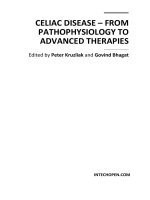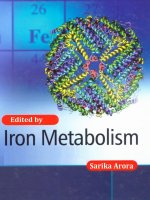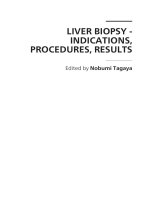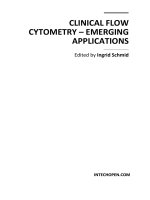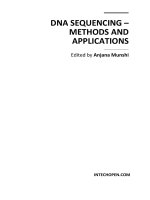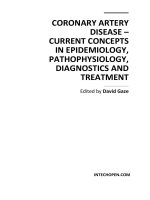Tachycardia Edited by Takumi Yamada ppt
Bạn đang xem bản rút gọn của tài liệu. Xem và tải ngay bản đầy đủ của tài liệu tại đây (3.41 MB, 212 trang )
TACHYCARDIA
Edited by Takumi Yamada
Tachycardia
Edited by Takumi Yamada
Published by InTech
Janeza Trdine 9, 51000 Rijeka, Croatia
Copyright © 2012 InTech
All chapters are Open Access distributed under the Creative Commons Attribution 3.0
license, which allows users to download, copy and build upon published articles even for
commercial purposes, as long as the author and publisher are properly credited, which
ensures maximum dissemination and a wider impact of our publications. After this work
has been published by InTech, authors have the right to republish it, in whole or part, in
any publication of which they are the author, and to make other personal use of the
work. Any republication, referencing or personal use of the work must explicitly identify
the original source.
As for readers, this license allows users to download, copy and build upon published
chapters even for commercial purposes, as long as the author and publisher are properly
credited, which ensures maximum dissemination and a wider impact of our publications.
Notice
Statements and opinions expressed in the chapters are these of the individual contributors
and not necessarily those of the editors or publisher. No responsibility is accepted for the
accuracy of information contained in the published chapters. The publisher assumes no
responsibility for any damage or injury to persons or property arising out of the use of any
materials, instructions, methods or ideas contained in the book.
Publishing Process Manager Molly Kaliman
Technical Editor Teodora Smiljanic
Cover Designer InTech Design Team
First published March, 2012
Printed in Croatia
A free online edition of this book is available at www.intechopen.com
Additional hard copies can be obtained from
Tachycardia, Edited by Takumi Yamada
p. cm.
ISBN 978-953-51-0413-1
Contents
Preface IX
Chapter 1 Accurate Detection
of Paediatric Ventricular Tachycardia in AED 1
U. Irusta, E. Aramendi, J. Ruiz and S. Ruiz de Gauna
Chapter 2 Surgical Maze Procedures
for Atrial Arrhythmias in Univentricular Hearts,
from Maze History to Conversion–Fontan 25
Charles Kik and Ad J.J.C. Bogers
Chapter 3 Definition, Diagnosis
and Treatment of Tachycardia 41
Anand Deshmukh
Chapter 4 Ryanodine Receptor Channelopathies:
The New Kid in the Arrhythmia Neighborhood 65
María Fernández-Velasco, Ana María Gómez,
Jean-Pierre Benitah and Patricia Neco
Chapter 5 The Effects of Lidocaine
on Reperfusion Ventricular Fibrillation
During Coronary Artery – Bypass Graft Surgery 89
Ahmet Mahli and Demet Coskun
Chapter 6 Tachycardia as “Shadow Play” 97
Andrey Moskalenko
Chapter 7 Metabolic Modulators
to Treat Cardiac Arrhythmias
Induced by Ischemia and Reperfusion 123
Moslem Najafi and Tahereh Eteraf-Oskouei
Chapter 8 Mechanisms of Ca
2+
–Triggered Arrhythmias 159
Simon Sedej and Burkert Pieske
VI Contents
Chapter 9 Heart Rate Variability:
An Index of the Brain–Heart Interaction 187
Ingrid Tonhajzerova, Igor Ondrejka, Zuzana Turianikova,
Kamil Javorka, Andrea Calkovska and Michal Javorka
Preface
Tachycardia is defined as a faster heart rhythm than normal sinus rhythm (with a rate
of greater than 100 beats per minute in humans). Tachycardias can occur from
different clinical backgrounds including congenital or acquired heart diseases,
electrophysiological mechanisms and origins. The diagnosis of tachycardias is made
by surface electrocardiograms and electrophysiological testing. The management and
treatment of tachycardias including pharmacological and non-pharmacological
approaches are determined based on these factors. These concerns have been studied
and the details have been increasingly recognized. In this book, internationally
renowned authors have contributed chapters detailing these concerns of tachycardias
from basic and clinical points of view and the chapters will lead to a further
understanding and improvement in the clinical outcomes of tachycardias.
Dr. Takumi Yamada
Distinguished Professor of Medicine,
Division of Cardiovascular Disease, University of Alabama at Birmingham,
USA
1. Introduction
Sudden cardiac death (SCD) is the single most important cause of death in the adult
population of the industrialized world (Jacobs et al., 2004). SCD accounts for 100–200 deaths
per 100 000 adults over 35 years of age annually (Myerburg, 2001). The most frequent cause of
SCD is fatal ventricular arrhythmias: ventricular fibrillation (VF) and ventricular tachycardia
(VT) (de Luna et al., 1989). In fact, degenerating VT to VF appears to be the mechanism for a
large majority of cardiac arrests (Luu et al., 1989).
Most sudden cardiac arrests occur out of hospital, and the annual incidence of out-of-hospital
cardiac arrest (OHCA) treated by emergency medical services in the USA is 55 per 100 000
of the population (Myerburg, 2001). Survival rates in untreated cardiac arrest decrease
by 7–10 % per minute (Larsen et al., 1993; Valenzuela et al., 1997), as the heart function
deteriorates rapidly. Consequently, early intervention is critical for the survival of OHCA
victims. The sequence of actions to treat OHCA includes rapid access to emergency services,
early cardiopulmonary resuscitation, early defibrillation and advanced cardiac life support
as soon as possible. These four links constitute what the American Heart Association
(AHA) calls the chain of survival. Compressions and ventilations during cardiopulmonary
resuscitation maintain a minimum blood flow until defibrillation is available. The only
effective way to terminate lethal ventricular arrhythmias and to restore a normal cardiac
rhythm is defibrillation, through the delivery of an electric shock to the heart.
Automated external defibrillators (AED) are key elements in the chain of survival. An
AED is a portable, user-friendly device that analyzes the rhythm acquired through two
electrode pads and delivers an electric shock if pulseless VT or VF is detected. The shock
advice algorithm (SAA) of an AED analyzes the electrocardiogram (ECG) to discriminate
between shockable and nonshockable rhythms. Given a database of classified ECG records,
the performance of the SAA is evaluated in terms of the proportion of correctly identified
shockable—sensitivity—and nonshockable—specificity—rhythms, which must exceed the
minimum values set by the AHA (Kerber et al., 1997).
SCD is 10 times less frequent in children than in adults. However, the social and emotional
impact of the death of a child is enormous. In the USA alone, an estimated 16 000 children
die each year from sudden cardiac arrest (Sirbaugh et al., 1999). The most common cause
of cardiac arrest in children is respiratory arrest, although the incidence of cardiac arrest
caused by ventricular arrhythmias increases with age (Appleton et al., 1995; Atkins et al.,
Accurate Detection of Paediatric Ventricular
Tachycardia in AED
U. Irusta, E. Aramendi, J. Ruiz and S. Ruiz de Gauna
University of the Basque Country
Spain
1
2 Will-be-set-by-IN-TECH
1998). Initially two independent studies provided evidence for the use of AED in paediatric
patients (Atkinson et al., 2003; Cecchin et al., 2001). Based on that evidence, in 2003, the
International Liaison Committee on Resuscitation (ILCOR) recommended the use of AED in
children aged 1–8 years (Samson et al., 2003). Since 2005, the resuscitation guidelines
1
have
incorporated this recommendation, which indicates the need to adapt AED for paediatric use.
This adaptation involves adjusting the defibrillation pads and energy dose, and, furthermore,
demonstrating that SAA accurately detect paediatric arrhythmias.
SAA of commercial AED were originally developed for adult patients. Adapting these
algorithms for paediatric use requires the compilation of shockable and nonshockable
rhythms from paediatric patients in order to assess their SAA performance. The first studies
on the use of AED in children showed that two adult SAAs from commercial AED accurately
identified many paediatric rhythms (Atkinson et al., 2003; Cecchin et al., 2001). The specificity
for nonshockable rhythms and the sensitivity for VF were above the values recommended
by the AHA. However, those studies failed to meet AHA criteria for shockable paediatric
VT. In 2008, a third study showed that a SAA designed for adult patients did not meet AHA
criteria for nonshockable paediatric supraventricular tachycardia (SVT) (Atkins et al., 2008).
This study suggested that the specificity of SAA originally designed for adult patients could
fail to meet AHA performance goals for paediatric SVT.
The SAA first extracts a set of discrimination parameters or features from the surface ECG
recorded by the AED, and then combines those features to classify the rhythm as shockable
or nonshockable. There are important differences in heart rate, amplitude and ECG wave
morphology between paediatric and adult rhythms (Cecchin et al., 2001; Rustwick et al., 2007).
The faster heart rates and shorter QRS durations of paediatric rhythms produce differences
in the values of the discrimination parameters which may affect the performance of SAA
designed for adult use. Some of these differences have been previously assessed, and the
discrimination power of several parameters has been evaluated for adult and paediatric
arrhythmias (Aramendi et al., 2006; 2010; 2007; Irusta et al., 2008; Ruiz de Gauna et al., 2008).
These studies underlined the inadequacy of many parameters and discrimination thresholds
for discriminating VT from SVT safely when adult and paediatric rhythms were considered.
A reliable SVT/VT discrimination algorithm is therefore a key requirement for adapting or
developing SAA for paediatric use.
This chapter comprises five sections. Section 2 describes the database compiled to develop
and test a SVT/VT discrimination algorithm in the context of AED arrhythmia classification.
More than 1900 records from adult and paediatric patients were compiled, and a thorough
description of the sources and rhythm classification process is given. Special attention is paid
to the SVT/VT subset, which contains more than 650 records. The criteria for classification
are reported, and heart rate analysis for both adult and paediatric populations is detailed. In
section 3, we conduct the spectral analysis of SVT and VT rhythms and define a number
of spectral parameters that discriminate between VT and SVT. Emphasis is placed on the
influence of the age group and the heart rate on the values of the parameters. Based on
these spectral parameters, a SVT/VT discrimination algorithm is designed in section 4. The
discriminative power of the algorithm is assessed through the receiver operating characteristic
(ROC) curve and the sensitivity/specificity values. The algorithm accurately discriminates
between SVT and VT in both adults and children, and it could safely be incorporated into
1
The latest version of the guidelines was released in 2010 (Biarent et al., 2010).
2
Tachycardia
Accurate Detection of Paediatric Ventricular Tachycardia in AED 3
SAA. Section 5 discusses the main conclusions of this work and analyzes what issues need
to be addressed when using adult SAA with children. Several strategies to adapt SAA for
paediatric use are discussed, and an overall scheme to adapt adult SAA for paediatric use,
integrating the SVT/VT discrimination algorithm described in section 4, is proposed.
2. Adult and paediatric data collection
The accurate identification of VT and SVT by an AED is well described in the 1997
AHA statement on the performance and safety of AED SAA (Kerber et al., 1997). The
AHA statement describes the composition of the databases used to develop and test SAA,
including the types of rhythms and the minimum number of records per rhythm type. It
divides the rhythm types into three categories: shockable, nonshockable and intermediate
2
.
It also specifies that within a rhythm type, all records must be obtained from different
patients. Finally, the statement defines the performance goals of the SAA for shockable and
non-shockable rhythms, i.e. the minimum sensitivity and specificity of the SAA per rhythm
type. These values are exhibited in table 1.
Rhythms
Minimun no. of
records Performance goal
Observed
performance 90 % One-sided CI
Shockable
Coarse VF
a
200 > 90 % Sens > 90 % 87 %
Rapid VT 50
> 75 % Sens > 75 % 67 %
Nonshockable 300 total
NSR 100
> 99 % Spec > 99 % 97 %
Other 30
> 95 % Spec > 95 % 88 %
Asystole 100
> 95 % Spec > 95 % 92 %
Intermediate
Fine VF 25 Report only – –
Other VT 25 Report only – –
a
Peak-to-peak amplitude above 200μV.
b
Specified by the manufacturer, because tolerance to VT varies widely among patients.
Table 1. Definition of the databases used to validate SAA, adapted from the AHA
statement (Kerber et al., 1997). The other nonshockable rhythms include supraventricular
tachycardia (SVT), atrial fibrillation, premature ventricular contractions, heart blocks, sinus
bradycardia and idioventricular rhythms. The 90 % one-sided confidence intervals (CI) are
computed for the observed performance goals. no.=number; NSR=normal sinus rhythm;
Sens=sensitivity; Spec=specificity; VF=ventricular fibrillation; VT=ventricular tachycardia.
Currently, there exists no public database of ECG records compliant with the AHA statement.
Each AED manufacturer compiles its own data, which must include paediatric rhythms
if the AED will be used to treat children. However, the studies describing paediatric
databases (Atkins et al., 2008; Atkinson et al., 2003; Cecchin et al., 2001) report fewer
shockable rhythms than those specified in the AHA statement because paediatric ventricular
arrhythmias are scarce.
2
Rhythms for which the benefits of defibrillation are uncertain.
3
Accurate Detection of Paediatric Ventricular Tachycardia in AED
4 Will-be-set-by-IN-TECH
An adult and a paediatric database were compiled using ECG records collected from in- and
out-of-hospital sources. Three cardiologists assigned a rhythm type and a shock/no-shock
recommendation to each record. For potentially shockable rhythms, the criteria by which
to determine the shock/no-shock recommendation were: the patient was unresponsive,
had no palpable pulse, and was of unknown age (Cecchin et al., 2001). Diagnostic
discrepancies among the reviewers were further discussed, and a consensus decision for the
shock/no-shock recommendation was agreed upon after the assessment of the risks. Most of
the reviewer disagreements in diagnosis occurred between SVT and VT rhythms.
The database contains shockable rhythms (VF and rapid VT) and the most representative
nonshockable rhythms: normal sinus rhythm (NSR) and SVT. Although the AHA includes
SVT among the other nonshockable rhythms (see table 1), we have added an individual SVT
category because adult SAA may fail to detect high-rate paediatric SVT (Atkins et al., 2008)
accurately. Although the complete database is initially described, the SVT/VT subset was
extracted to study VT discrimination. We considered VT shockable for heart rates above
150 bpm in adults and 20 bpm above the age-matched normal rate in children (Atkinson et al.,
2003), which amounts to 180 bpm in infants (under 1 year) and 150 bpm in children older than
1 year. Table 2 presents a summary of the database, where the paediatric data are divided into
three age groups: under 1 year, 1–8 years (ILCOR recommendation) and above 8 years. All
records were stored with a common format and sampling frequency of f
s
= 250 Hz.
Paediatric
Rhythms <1y 1y–8y >8y Total Adult Minimum
a
Shockable
Coarse VF 3 (1) 18 (11) 37 (10) 58 (22) 374 (374) 200
Rapid VT 8 (4) 39 (19) 19 (13) 66 (33) 200 (200) 50
Nonshockable
NSR 14 (13) 312 (280) 214 (161) 540 (454) 292 (292) 100
SVT 38 (29) 147 (103) 137 (104) 322 (236) 89 (89) 30
Total 63 (39) 516 (357) 407 (216) 986 (612) 955 (820) –
a
As specified in the AHA statement for adult records, see table 1.
Table 2. Number of records per rhythm class in the adult and paediatric databases. The
number of patients is indicated in parentheses. Asystole and intermediate rhythms were
excluded from the analysis, and the others category is composed of SVT. The SVT/VT subset
is highlighted.
2.1 Adult records
The adult database contains 955 records from 820 patients: 574 shockable records from 541
patients and 381 nonshockable records from 351 patients. The mean duration of the records
was 13.0
± 5.3 s overall, with 15.4 ±4.2 s for the nonshockable and 11.4 ± 5.4 s for the shockable
records. The adult database was compiled following the AHA statement; hence, all records
within a rhythm type come from different patients.
4
Tachycardia
Accurate Detection of Paediatric Ventricular Tachycardia in AED 5
The adult records were obtained from three sources. Two hundred fifty-one nonshockable and
63 shockable records were extracted from public ECG databases
3
. The adult data also include
127 nonshockable and 325 shockable records from in-hospital electrophysiology (EP) studies
and intensive care units at two Spanish hospitals (Basurto and Donostia hospitals). Finally,
the database contains three nonshockable and 186 shockable out-of-hospital records recorded
by two Spanish emergency services in Madrid and in the Basque Country.
Public databases are available in digital format with different sampling rates and storage
formats. In-hospital data were gathered in digital format (Prucka Cardiolab and EP-Tracer
systems) or as printed ECG paper strips. All out-of-hospital data came in paper format from
AED printouts.
2.2 Paediatric records
The paediatric database contains 986 records from 612 paediatric and adolescent patients
aged between 1 day and 20 years (mean age, 7.1
± 4.5 years). There are 862 nonshockable
records from 579 patients and 124 shockable records from 49 patients. The mean duration
of the records was 13.7
± 9.0 s, with 14.1 ± 9.3 s for the nonshockable and 10.9 ± 4.9 s for the
shockable records.
Shockable paediatric rhythms were difficult to obtain because lethal ventricular arrhythmias
are rare in children. Furthermore, their occurrence increases with age, and this is reflected
in our database, in which most VF rhythms were collected from patients aged 9 years or
older. Several records from the same patient were included in the same rhythm type when
the morphology of the arrhythmias was different. This procedure is contrary to the AHA
statement; however, all studies on the use of SAA in children have allowed rhythm repetition
because paediatric ventricular arrhythmias are scarce (Atkins et al., 2008; Atkinson et al., 2003;
Cecchin et al., 2001; Irusta & Ruiz, 2009).
All the paediatric records were collected in hospitals, from archived paper and digital EP
studies (Prucka Cardiolab and EP-Tracer systems). The records were retrospectively obtained
from five Spanish hospitals: Cruces, Donostia, La Paz, Gregorio Marañón and San Joan de
Deu.
2.3 Analysis of the SVT/VT subset
Accurate discrimination between SVT and VT is crucial in order to adapt adult SAA for
paediatric use (Atkins et al., 2008; Irusta & Ruiz, 2009). Consequently, the SVT/VT subset was
extracted from the collected data in order to analyze the accurate detection of VT in the context
of a SAA. We will use this subset to compare the characteristic features of each rhythm and
to define a set of parameters that discriminate between SVT and VT in adult and paediatric
patients.
The SVT/VT database consists of 677 rhythms distributed as described in table 2. There are
89 adult and 322 paediatric SVT records, and 200 adult and 66 paediatric VT records. The
subset includes a large number of paediatric SVT, which is, in the context of SAA, the most
challenging rhythm type for accurate detection of VT (Aramendi et al., 2010; Atkins et al.,
2008; Irusta & Ruiz, 2009).
3
The MIT-BIH arrhythmia, the AHA and Creighton University ventricular tachyarrhythmia databases.
5
Accurate Detection of Paediatric Ventricular Tachycardia in AED
6 Will-be-set-by-IN-TECH
Several records from the SVT/VT database were the most difficult to agree on for the
cardiologists who classified the records in our databases. Based on a single-lead recording of
a duration of approximately 10 s, consensus was not always easy. Fig. 1 shows four paediatric
examples in which similar heart rates correspond to different rhythms. The cases shown in
Figs 1(a) and 1(d) have the same 255 bpm heart rate, but there is atrial activity in the former
and exclusively ventricular activity the latter. In general, disagreements were resolved by
adopting the original interpretation of the physician aware of the clinical history of the patient.
This interpretation is more reliable, but it is only available when records are obtained from
documented EP studies. For out-of-hospital records, forced consensus was used to integrate
the record in the database.
02
4
68
10
−0.75
0
1.25
(a) Paediatric SVT with disagreements in diagnosis (heart rate 255 bpm).
02
4
68
10
−0.30
0
0.30
(b) Paediatric SVT with disagreements in diagnosis (heart rate 125 bpm).
02
4
68
10
−0.70
0
0.50
(c) Paediatric VT with disagreements in diagnosis (heart rate 210 bpm).
02
4
68
10
−1.50
0
0.70
(d) Paediatric VT with disagreements in diagnosis (heart rate 255 bpm).
Fig. 1. Paediatric supraventricular tachycardia (SVT) and ventricular tachycardia(VT) records
that required a forced consensus between cardiologists for the rhythm classification.
For an accurate SVT/VT diagnosis, attention should be paid to the differences in the ECG
between adults and children. It is well known that to maintain cardiac output, children
present higher heart rates to compensate for smaller stroke volumes (Rustwick et al., 2007).
With age, stroke volume increases and contributes more significantly to overall cardiac output.
The duration of the QRS complex is shorter in children than in adults because of the smaller
6
Tachycardia
Accurate Detection of Paediatric Ventricular Tachycardia in AED 7
cardiac muscle mass in children (Chan et al., 2008), while the QT interval is similar in children
and adults. The QT interval, however, depends on and is normally adjusted to the heart rate.
SVT is the most common paediatric tachydysrhythmia. SVT heart rates are typically above
220 bpm in infants and above 180 bpm in children (Manole & Saladino, 2007). SVT is usually
associated with an accessory atrioventricular pathway in neonates and young children. In
adolescents and adults, the most common cause of SVT is an atrioventricular nodal reentry
tachycardia (Chan et al., 2008).
Although SVT is more common in children, tachycardias of ventricular origin do occur in
paediatric patients (Chan et al., 2008). As the normal QRS complex is of shorter duration in
children than in adults, VT is more difficult to diagnose in young children. What appears as a
slightly prolonged QRS complex in the ECG may, in fact, represent a significantly prolonged or
wide complex tachycardia in infants and children. Consequently morphology features rather
than rate information should be considered by the SVT/VT discrimination algorithm.
2.4 Analysis of the heart rate
Heart rate (HR) calculations are inherent to many SAA because fatal ventricular arrhythmias
are associated with very high ventricular rates. We have analyzed the HR for the SVT/VT
database in order to assess the effect of patient age on the HR for SVT and VT rhythms. QRS
complexes were automatically detected, and results were visually inspected and corrected
when necessary. The value of the HR for each record was computed as the inverse of the
mean RR interval, and the result is given in beats per minute (bpm)
4
:
HR
(bpm)=60 ·
1
RR (s)
, (1)
where
RR is the mean RR interval expressed in seconds.
Table 3 shows the mean HR of the nonshockable SVT and the shockable VT records for all age
groups—adult and paediatric. The mean values of the HR were compared using the unequal
variance t-test and a value of p
< 0.001 was considered significant. The HR for paediatric SVT
(187 bpm) was significantly higher than for adult SVT (131 bpm) (p
< 0.001). Furthermore,
the database contains 19 SVT values from infants with HR values above 180 bpm and 222 SVT
values from children aged 1 year or older with HR values above 150 bpm; i.e., with rates above
the threshold for shockable VT. The mean HR values did not differ significantly between adult
VT (241 bpm) and paediatric VT (232 bpm) (p
= 0.39).
The high rate of paediatric SVT largely overlaps with paediatric and adult VT rates. This
fact is clearly shown in Fig. 2, in which the normalized histograms of the HR values for the
SVT and VT records are plotted for the different populations. The overlap between the HR
histograms of SVT and VT records is larger in the paediatric population (Fig. 2(b)) than in
the adult population (Fig. 2(a)). When both population groups are aggregated (Fig. 2(c)), the
overlap remains because the HR of paediatric SVT overlaps with that of adult and paediatric
VT. This overlap precludes poor SVT/VT discrimination based exclusively on the HR.
4
All the signal processing algorithms and calculations described in this chapter were carried out using
MATLAB (MathWorks, Natick, MA), version 7.10.0.
7
Accurate Detection of Paediatric Ventricular Tachycardia in AED
8 Will-be-set-by-IN-TECH
Paediatric
Rhythms <1y 1y–8y >8y Total Adult p value
SVT 186 ± 45 194 ± 39 180 ± 39 187 ± 40 131 ± 32 <0.001
VT 226
± 31 247 ± 57 206 ± 46 232 ± 54 241 ± 58 0.3857
Table 3. Mean heart rate (HR) (mean ± standard deviation) expressed in bpm for the SVT/VT
database. The difference in mean HR between adult and paediatric patients is significant for
SVT but not for VT.
Fig. 3 shows the results of the analysis of the HR for the complete database, including NSR,
VT and SVT rhythms
5
. The HR distribution shows a clearer separation between VT and the
nonshockable rhythms (NSR and SVT), particularly for the adult patients (Fig. 3(a)). Although
a SAA based on HR dependent parameters might be reliable enough for adults, such an
approach will fail when high-rate paediatric SVT is considered, compromising both paediatric
SVT specificity and the overall VT sensitivity.
Many SAAs base their shock/no-shock decisions on heart rate calculations. Discrimination
parameters of adult SAA that strongly depend on the heart rate fail to diagnose paediatric
SVT accurately as nonshockable (Aramendi et al., 2010; Atkins et al., 2008), compromising
the specificity of the SAA. The addition of high-rate paediatric SVT to a database to test SAA
may compromise not only SVT specificity, but also VT sensitivity. It is therefore necessary to
develop safe SVT/VT discrimination algorithms based on heart rate independent features.
3. Spectral analysis
As shown in Fig. 2, the HR of paediatric SVT presents a large overlap with the HR of adult
and paediatric VT. The accurate discrimination of VT by an AED SAA must therefore rely on
ECG features not affected by the HR. Power spectral analysis of the ECG, which quantifies the
power distribution of the ECG as a function of frequency, is an adequate and simple tool for
the definition of HR-independent features.
3.1 Power spectral distribution
Following standard AED practice, the ECG was first preprocessed with an order 6 Butterworth
band-pass filter (0.7–35 Hz) to suppress baseline wander and power line interferences. The
preprocessed ECG, x
ecg
, was analyzed using nonoverlapping segments of 3.2 s duration, and
a maximum of three segments per record were used. Each segment was windowed using a
Hamming window, and the power spectral density (PSD) of the segment was estimated as the
square of the amplitude of the fast Fourier transform (FFT), zero padded to 4096 points.
Some frequency components of the ECG segment were made zero: frequency components
outside the 0.7 –35 Hz analysis band; and insignificant components, defined as those with
amplitudes below 5% of the maximum amplitude of the FFT (Barro et al., 1989). The PSD
5
VF records were excluded from the analysis because VF is an irregular ventricular rhythm characterized
by the absence of QRS complexes and a well-defined heart rate.
8
Tachycardia
Accurate Detection of Paediatric Ventricular Tachycardia in AED 9
HR (bpm)
100
150
200 250
300 350
0
0.008
0.016
0.024
(a) HR distribution of the adult SVT and VT
records.
HR (bpm)
100
150
200
250
300 350
0
0.005
0.010
0.015
(b) HR distribution of the paediatric SVT and VT
records.
HR (bpm)
100
150
200 250
300
350
0
0.004
0.008
0.012
(c) HR distribution of SVT and VT records, for
the adult and paediatric populations.
Fig. 2. Heart rate (HR) distributions for each population group for the SVT records () and
VT records (
).
normalized to a unit area under the curve, P
xx
( f ), was then estimated as:
P
xx
( f )=
|
X
ecg
( f )|
2
35 Hz
∑
f =0.7 Hz
|X
ecg
( f )|
2
, (2)
where X
ecg
( f ) is the FFT of the 3.2 s segment after zeroing the components mentioned above.
P
xx
( f ) was then used to define a set of spectral features that capture the morphological
differences between the PSD of VT and SVT rhythms.
9
Accurate Detection of Paediatric Ventricular Tachycardia in AED
10 Will-be-set-by-IN-TECH
HR (bpm)
50
100
150
200 250
300 350
0
0.008
0.016
0.024
(a) HR distribution of the adult records in the
complete database.
HR (bpm)
50
100
150
200
250
300 350
0
0.005
0.010
0.015
(b) HR distribution of the paediatric records in
the complete database.
HR (bpm)
50
100
150
200 250
300
350
0
0.005
0.010
0.015
(c) HR distribution of the records in the complete
database, adult and paediatric combined.
Fig. 3. HR distributions for each population group for the complete database: nonshockable
records (
) and VT records ().
Both monomorphic VT and SVT are regular rhythms. The morphology of the QRS complex
changes slowly from beat to beat, and beats occur at very regular intervals. These rhythms
can therefore be regarded as quasiperiodic, and their power spectrum concentrates around the
harmonics of the fundamental frequency. The beat repetition period is the mean RR interval,
RR, so the fundamental frequency is the cardiac frequency:
f
c
(Hz)=
1
RR (s)
. (3)
The harmonics are located at the integer multiples of the cardiac frequency:
f
k
= k · f
c
. (4)
10
Tachycardia
Accurate Detection of Paediatric Ventricular Tachycardia in AED 11
Although SVT and VT distribute their power around the harmonic frequencies, f
k
, the relative
power content of each harmonic is very different in SVT and VT. The examples in Fig. 4, which
represent a typical P
xx
( f ) for a VT and a SVT, illustrate such differences.
Monomorphic VT presents wide QRS complexes that frequently resemble a sinus-like
waveform. In the frequency domain, most of the power of the ECG is concentrated in a
narrow frequency band around f
c
, which corresponds to the ventricular rate of the VT (see
Fig. 4(a) for an example). Rather than using the RR intervals computed in the time domain,
the ventricular rate can easily be estimated in the frequency domain as the frequency at which
P
xx
( f ) is at its maximum:
f
d
(Hz)= arg max
f ∈(0.7−35)
{P
xx
( f )}. (5)
This frequency is called the dominant frequency and has been extensively used to
characterize ventricular arrhythmias and to estimate the effectiveness of defibrillation
shocks (Strohmenger et al., 1996).
t (s)
x
ecg
(mV)
0
1
2
3
4
−0.60
0.00
0.60
f (Hz)
P
xx
( f )
0
f
d
≈ f
c
10 15
20
25 30
0
0.05
0.10
0.15
(a) A VT with a ventricular rate of 214 bpm (3.6 Hz) in the time and frequency domains. For VT most
of the power is concentrated around the dominant frequency, f
d
≈ f
c
= 4 Hz, which corresponds to the
ventricular rate.
t (s)
x
ecg
(mV)
0
1
2
3
4
−0.75
0.00
0.75
f (Hz)
P
xx
( f )
0
f
c
f
d
10 15
20
25 30
0
0.02
0.04
0.06
(b) A SVT with a heart rate of 208 bpm (3.5 Hz) in the time and frequency domains. In this case, the
dominant frequency appears in the second harmonic, f
d
≈ 2 f
c
= 7 Hz, which corresponds to twice the
heart rate. Most of the power is distributed among the higher harmonics.
Fig. 4. Examples of a SVT and VT in the time and frequency domains. Although in both cases
power is distributed among the harmonics of f
c
, the power content of the harmonics is very
different.
During SVT, the ECG changes more abruptly; QRS complexes are narrower, and the signal
power is distributed among several harmonics of the cardiac frequency. The number of
harmonics can be large because of the rapid variations in the QRS complexes, and the power
11
Accurate Detection of Paediatric Ventricular Tachycardia in AED
12 Will-be-set-by-IN-TECH
f
c
f
d
2
3
4
567
2
3
4
5
6
7
(a) VT. The dominant frequency accurately
represents the ventricular rate.
f
c
f
d
1
2
3
4
5
4
8
12
16
(b) SVT. The dominant frequency frequently
appears in higher harmonics as shown by lines
of increasing slope.
Fig. 5. Relation between f
d
computed in the frequency domain and f
c
computed in the time
domain for SVT and VT.
is therefore distributed in a larger frequency band than for VT, as shown in the example in
Fig. 4(b). Frequently, P
xx
( f ) is at its maximum at a high harmonic (k > 1), so the dominant
frequency is a multiple of the cardiac frequency rather than the cardiac frequency itself (k
= 1).
3.2 Relation between f
d
and f
c
in SVT and VT
We conducted a standard Pearson correlation analysis in order to investigate further the
relation between f
c
and f
d
in our database of SVT and VT. We used the first 3.2 s segment to
estimate f
d
. In this way, we compared the cardiac frequency obtained from the identification
of the QRS complexes in the time domain f
c
, equation (3), to the dominant frequency obtained
from the spectral analysis of the ECG, f
d
.
Fig. 5 shows the relation between f
d
and f
c
for all the SVT and the VT records in the database.
As shown in Fig. 5(a), f
d
≈ f
c
for all VT instances in our database; there are no outliers, and
the correlation coefficient is almost one (r
= 0.998). The relation is more complex for SVT,
however, as shown in Fig. 5(b). There are four lines of increasing slope corresponding to
f
d
= k · f
c
for k = 1, , 4, and the correlation coefficient is low (r = 0.134). Furthermore, these
lines cover cardiac frequencies in the 2
− 4 Hz range, indicating that the dominant frequency
may fall in a higher harmonic for a large range of SVT heart rates (120–240 bpm). When the
cardiac frequency of SVT is above 4 Hz, the dominant frequency corresponds to the cardiac
frequency.
The mean values for f
d
, f
c
and the correlation coefficient between these two variables r( f
d
, f
c
)
are compiled in Table 4. This table presents the results for both types of rhythms and also for
adult and paediatric patients. The differences in the values of the frequencies between adult
and paediatric rhythms are not significant for VT, while paediatric SVT presents significantly
higher dominant and cardiac frequencies, as expected from the HR analysis described in
section 2.3. The relative difference between the dominant and the cardiac frequency is smaller
12
Tachycardia
Accurate Detection of Paediatric Ventricular Tachycardia in AED 13
in the paediatric population because paediatric SVT with heart rates above 240 bpm are
frequent in our database, and in those cases, f
d
≈ f
c
.
In summary, the dominant frequency of VT rhythms has a clear physiological interpretation as
the ventricular rate of the arrhythmia, which can therefore be easily estimated in the frequency
domain. For SVT, the dominant frequency customarily falls in one of the first four harmonic
frequencies and only when the heart rate is very high (above 240 bpm) can it be interpreted as
the heart rate.
3.3 Distribution of the power content
In this section we analyze how the power of the ECG is distributed among the different
harmonics of the cardiac frequency. VT rhythms will concentrate most of their power around
the fundamental component (f
c
≈ f
d
). For SVT, the signal power will be distributed
among several harmonics of f
c
. These differences are caused by the morphology of
the arrhythmias—wide sinus-like QRS complexes in VT and narrower QRS complexes in
SVT—and are, for the most part, independent of the heart rate.
Let P
k
stand for the power content percentage of the k
th
harmonic. We estimated this value by
adding all power components in a f
c
(Hz) frequency band centered in k · f
c
:
P
k
(%)=100 ·
kf
c
+0.5 f
c
∑
kf
c
−0.5 f
c
P
xx
( f ) k = 1 , , 10. (6)
A graphical example of the computation of the power of the harmonics is shown in Fig. 6 for
a SVT and a VT.
Table 5 compares the values of P
k
between SVT and VT for all age groups in our database:
paediatric, adult and all patients. VT rhythms present small differences in harmonic content
between adults and children. On average, P
1
accounts for over 80 % of the total power, and it
always has the largest power content—as we already know from the analysis of the dominant
frequency. The value of P
1
slightly increases as the heart rate increases, but the dependence is
very weak (r
= 0.28), as shown in Fig. 7. Although the difference is not large, P
1
is smaller in
paediatric VT than in adult VT; in fact, children may have VT with narrower QRS complexes
with durations under 90 ms (Schwartz et al., 2002). The total power content of the first three
harmonics accounts for over 95 % of the total power in VT, both in children and in adults.
paediatric Adult Total
Parameter SVT VT SVT VT SVT VT
f
c
(Hz) 3.1 ±0.7 3.9 ±0.9 2.2 ±0.5 4.0 ±1.0 2.9 ±0.8 4.0 ±1.0
f
d
(Hz) 5.2 ± 2.8 3.9 ± 0.9 4.3 ± 2.6 4.0 ± 1.0 5.0 ± 2.8 4.0 ± 1.0
r
( f
d
, f
c
)
0.06 1.00 0.19 1.00 0.13 1.00
(-0.05-0.17) (1.00-1.00) (-0.02-0.38) (1.00-1.00) (0.04-0.23) (1.00-1.00)
Table 4. Mean value (mean ± standard deviation) of f
c
and f
d
by rhythm type and
population group. The correlation coefficient r
( f
d
, f
c
) between these variables and its
corresponding 95 % CI are also reported.
13
Accurate Detection of Paediatric Ventricular Tachycardia in AED
14 Will-be-set-by-IN-TECH
On average, SVT presents up to six significant harmonics
6
, although some adult SVT have
over 10 significant harmonics. When the heart rate is low, SVT may present a larger number
of significant harmonics. This explains why the power content of the lower harmonics is
smaller in adult than in paediatric SVT. On average, the higher SVT harmonics (k
≥ 4) contain
40 % of the total power: 47 % in adults and 37 % in children. In this study, we define P
H
, the
P
1
= 18
P
2
= 33
P
3
= 14
P
4
= 13
P
5
= 10
P
6
= 5
P
7
= 4
P
8
= 2
f
(Hz)
P
xx
( f )
1 f
c
2 f
c
3 f
c
4 f
c
5 f
c
6 f
c
7 f
c
8 f
c
0
0.02
0.04
0.06
(a) Power is distributed among several harmonics in SVT, with up to six
significant harmonics.
P
1
= 89
P
2
= 11
f
(Hz)
P
xx
( f )
1 f
c
2 f
c
0
0.06
0.12
0.18
(b) Most power is concentrated around the fundamental component in VT
( f
c
= f
d
).
Fig. 6. Computation of the power content of the harmonics, for the examples shown in Fig.4.
6
Harmonics that contribute at least 5 % of the total power.
14
Tachycardia
Accurate Detection of Paediatric Ventricular Tachycardia in AED 15
paediatric Adult Total
P
k
SVT VT SVT VT SVT VT
k = 128(6 − 56) 83 (71 − 92) 23 (3 − 51) 88 (76 − 96) 27 (5 − 55) 86 (75 − 96)
k = 219(8 − 31) 10 (3 − 18) 18 (7 − 33) 8 (2 − 17) 19 (8 − 32) 9 (2 − 18)
k = 316(8 − 23) 3 (1 − 8) 12 (6 − 19) 2 (0 − 4) 15 (7 − 22) 2 (0 − 6)
k = 412(6 − 17) 2 (0 − 4) 11 (5 − 17) 1 (0 − 2) 12 (6 − 17) 1 (0 − 3)
k = 58(3 − 13) 1 (0 − 2) 9 (4 − 12) 0 (0 − 1) 9 (3 − 13) 0 (0 − 1)
k ≥ 617(3 − 36) 1 (0 − 1) 25 (5 − 48) 0 (0 − 1) 18 (3 − 40) 0 (0 − 1)
Table 5. Mean content of the harmonics by rhythm type and population group. The range in
parentheses represents the 10-90 percentile range.
power content of the higher harmonics (k
≥ 4), in the following way:
P
H
=
∑
k≥4
P
k
. (7)
The values of P
H
slowly decrease as the heart rate increases, as shown in Fig. 8, which explains
the differences in power distribution between adult and paediatric SVT. These differences are
not large, however, because P
H
depends very weakly on the heart rate (r = −0.37).
In summary, the differences in spectral content between SVT and VT are large, regardless of
the age group. VT concentrates its power around the fundamental component: on average,
P
1
contains over 80 % of the total power, and P
H
less than 5 %. The small differences between
adult and paediatric VT are caused by the narrower QRS complexes in paediatric VT, since
the heart rates of adult and paediatric VT in our database are not significantly different. SVT
distributes its power among many harmonics: on average, P
1
contains less than 30 % of the
total power, and P
H
more than 35 %. The power content of the higher harmonics is smaller in
paediatric SVT than in adult SVT because the heart rate in paediatric SVT is larger; however,
the differences are not large.
4. An accurate SVT/VT discrimination algorithm
The spectral differences between SVT and VT described in the previous section are, for the
most part, independent of the heart rate. An accurate SVT/VT discrimination algorithm valid
for adult and paediatric patients can therefore be designed based on those differences. In this
work, we propose the use of two spectral features described in the preceding section: P
1
and
P
H
.
Fig. 9(a) and Fig. 9(b) show the histograms of the two spectral parameters for the SVT and
VT records, both in adult and paediatric cases. Both parameters show a clear separation,
which is independent of the age group, between the types of arrhythmias. This confirms their
adequacy for discriminating between VT and SVT accurately in children and adults.
4.1 Classification algorithm
The adult and paediatric databases were randomly split into two groups containing equal
numbers of patients. The first database was used to develop the SVT/VT algorithm, and the
15
Accurate Detection of Paediatric Ventricular Tachycardia in AED
